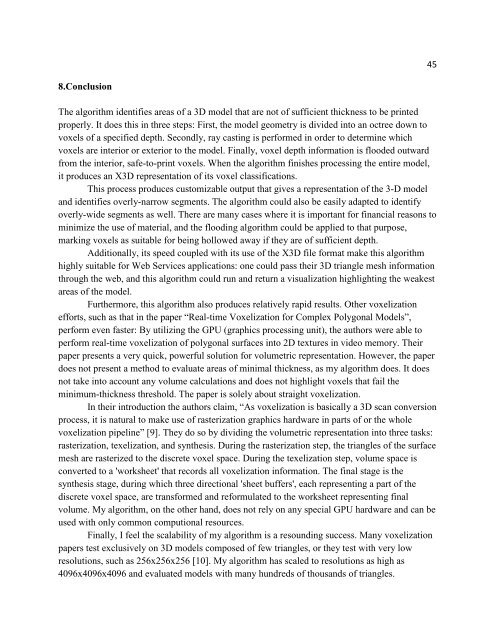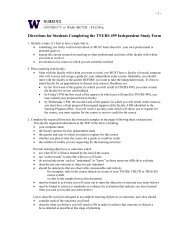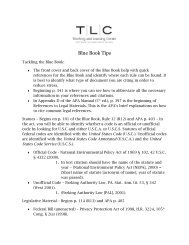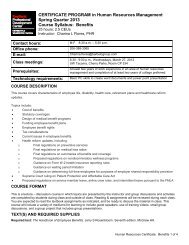1 Using Voxelization and Ray-Tracing to Identify Wall Thinness of ...
1 Using Voxelization and Ray-Tracing to Identify Wall Thinness of ...
1 Using Voxelization and Ray-Tracing to Identify Wall Thinness of ...
Create successful ePaper yourself
Turn your PDF publications into a flip-book with our unique Google optimized e-Paper software.
458.ConclusionThe algorithm identifies areas <strong>of</strong> a 3D model that are not <strong>of</strong> sufficient thickness <strong>to</strong> be printedproperly. It does this in three steps: First, the model geometry is divided in<strong>to</strong> an octree down <strong>to</strong>voxels <strong>of</strong> a specified depth. Secondly, ray casting is performed in order <strong>to</strong> determine whichvoxels are interior or exterior <strong>to</strong> the model. Finally, voxel depth information is flooded outwardfrom the interior, safe-<strong>to</strong>-print voxels. When the algorithm finishes processing the entire model,it produces an X3D representation <strong>of</strong> its voxel classifications.This process produces cus<strong>to</strong>mizable output that gives a representation <strong>of</strong> the 3-D model<strong>and</strong> identifies overly-narrow segments. The algorithm could also be easily adapted <strong>to</strong> identifyoverly-wide segments as well. There are many cases where it is important for financial reasons <strong>to</strong>minimize the use <strong>of</strong> material, <strong>and</strong> the flooding algorithm could be applied <strong>to</strong> that purpose,marking voxels as suitable for being hollowed away if they are <strong>of</strong> sufficient depth.Additionally, its speed coupled with its use <strong>of</strong> the X3D file format make this algorithmhighly suitable for Web Services applications: one could pass their 3D triangle mesh informationthrough the web, <strong>and</strong> this algorithm could run <strong>and</strong> return a visualization highlighting the weakestareas <strong>of</strong> the model.Furthermore, this algorithm also produces relatively rapid results. Other voxelizationefforts, such as that in the paper “Real-time <strong>Voxelization</strong> for Complex Polygonal Models”,perform even faster: By utilizing the GPU (graphics processing unit), the authors were able <strong>to</strong>perform real-time voxelization <strong>of</strong> polygonal surfaces in<strong>to</strong> 2D textures in video memory. Theirpaper presents a very quick, powerful solution for volumetric representation. However, the paperdoes not present a method <strong>to</strong> evaluate areas <strong>of</strong> minimal thickness, as my algorithm does. It doesnot take in<strong>to</strong> account any volume calculations <strong>and</strong> does not highlight voxels that fail theminimum-thickness threshold. The paper is solely about straight voxelization.In their introduction the authors claim, “As voxelization is basically a 3D scan conversionprocess, it is natural <strong>to</strong> make use <strong>of</strong> rasterization graphics hardware in parts <strong>of</strong> or the wholevoxelization pipeline” [9]. They do so by dividing the volumetric representation in<strong>to</strong> three tasks:rasterization, texelization, <strong>and</strong> synthesis. During the rasterization step, the triangles <strong>of</strong> the surfacemesh are rasterized <strong>to</strong> the discrete voxel space. During the texelization step, volume space isconverted <strong>to</strong> a 'worksheet' that records all voxelization information. The final stage is thesynthesis stage, during which three directional 'sheet buffers', each representing a part <strong>of</strong> thediscrete voxel space, are transformed <strong>and</strong> reformulated <strong>to</strong> the worksheet representing finalvolume. My algorithm, on the other h<strong>and</strong>, does not rely on any special GPU hardware <strong>and</strong> can beused with only common computional resources.Finally, I feel the scalability <strong>of</strong> my algorithm is a resounding success. Many voxelizationpapers test exclusively on 3D models composed <strong>of</strong> few triangles, or they test with very lowresolutions, such as 256x256x256 [10]. My algorithm has scaled <strong>to</strong> resolutions as high as4096x4096x4096 <strong>and</strong> evaluated models with many hundreds <strong>of</strong> thous<strong>and</strong>s <strong>of</strong> triangles.
















